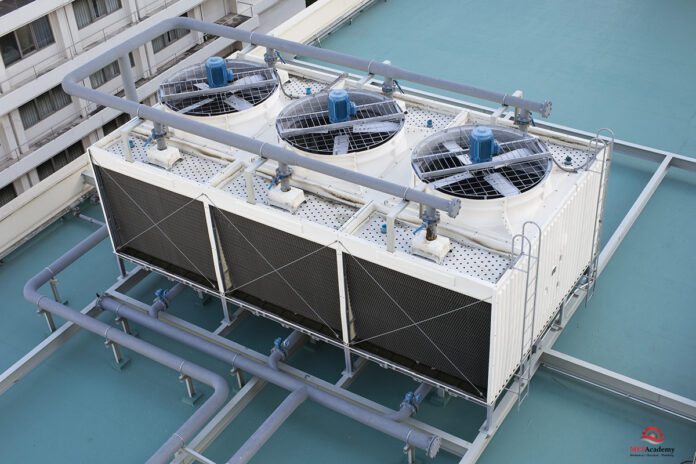Cooling towers are used to remove heat from water used in water-cooled applications. The heat is rejected to the atmospheric air that is passed through the system fill in a crossflow or counterflow method. A small percentage of the hot water from the system evaporates, cooling the remaining water which falls into the cold-water basin which is then pumped from the cold water basin to the system to absorb more heat in a continuous process.
It’s important to consider the efficiency of the cooling towers ability to reject heat for your project requirements. When you have the project requirements in the way of total tons, range and approach, then you can begin to analyze the cooling towers that would be appropriate for your water-cooled application.
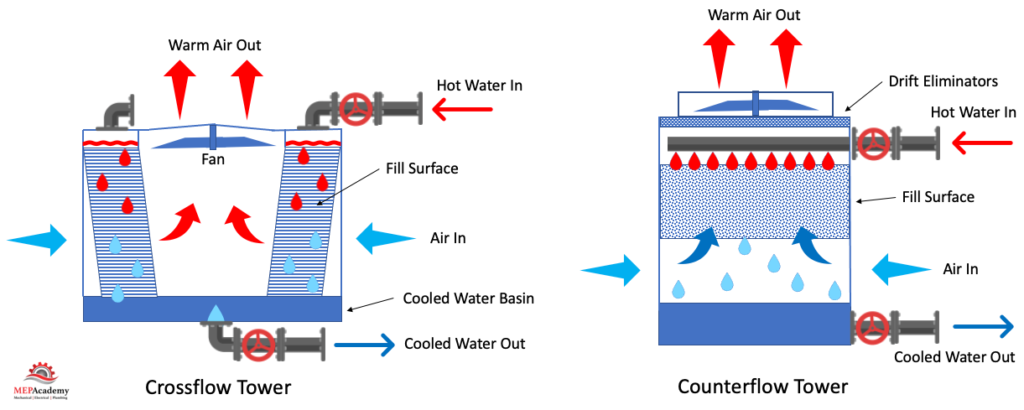
Induced draft crossflow and counterflow cooling towers both offer advantages and disadvantages based on specific project requirements and site conditions.
The obvious difference is in the method by which the air moves through the cooling tower in relationship to the cooling water, which is indicated by its description of a being crossflow or counterflow.
With a crossflow tower the air travels horizontally perpendicular) to the water traveling vertically down to the cold basin. With a counterflow cooling tower, air travels in the opposite direction vertically upward against the stream of falling water.
Cooling Tower Footprint – Physical Size
Air is required in sufficient amounts to accomplish the heat transfer requirements at the design conditions and at varying amounts for less than design conditions. Consideration must be made for this volume of air and the space required in the design of the tower to ensure the proper volume of air effectively interacts with the cooling water.
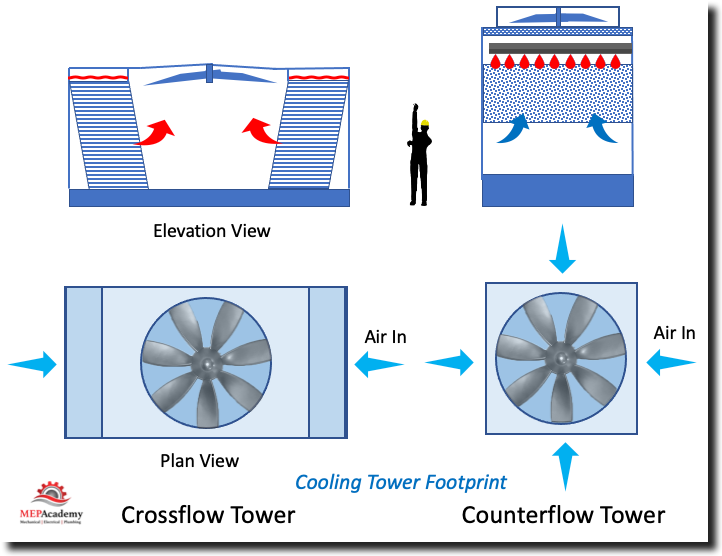
Cooling tower manufactures will have different footprint thresholds where the vertically configured counterflow goes from the smaller footprint to the larger footprint. Because of the nature of the counterflow tower where the air and water interact vertically, this allows for a smaller footprint most of the time in towers around 800 tons or less. As cooling towers get larger than 800 tons, the advantage could switch to counterflow.
Site conditions will determine whether the physical size of the cooling towers footprint is more important, or any height restrictions imposed by site factors.
Maintenance
In order to keep the cooling tower operating for efficiently and for its useful life it’s important to provide periodic maintenance. This will require that you consider tower access as a factor in the design and location of the tower.
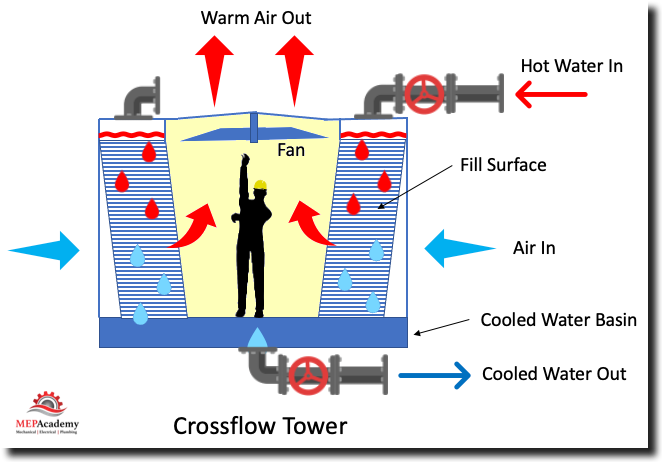
Access to the internal working parts various between the two designs. With the crossflow tower most of the internal parts are easily accessible as the fill material surrounds the exterior portions of the insides, allowing for access to the fan, motor, drift eliminators and cold-water basin. With larger crossflow cooling towers, the manufactures have an option to have ladders and platforms preinstalled for easy access to the motor and drive.
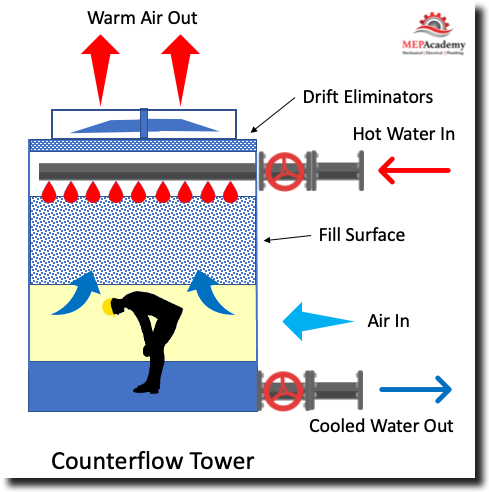
Access to the components of a counterflow tower are less friendly to the maintenance personnel because the overhead horizontal fill material provides a barrier between various components. The fan, motor, eliminators and spray system have limited access because they are located above the horizontal fill making then inaccessible from the cold-water basin.
Cooling Tower Operating Weight
Because of the crossflow towers larger footprint, it’s shipping and operating weight will often be greater than that of the counterflow tower. The bigger footprint of the counterflow tower can require additional structural support legs.
Water Distribution – Pressurized or Gravity
With the crossflow tower there is a hot-water basin above the fill that distributes the water that is pumped to the top of the tower. The water in the hot-water basin than makes its way through the distribution nozzles by gravity without the force of the pump. This allow for easier maintenance of the nozzles since the water is gravity fed and out of the air stream.
The design of the counterflow tower and the method by which the water descends in direct opposition to the vertically induced air, necessitates the need to pressurize the water distribution. Since the water is under pressure through the nozzles this requires that you shutoff the pump in order to clean or service the distribution system.
Another design and maintenance consideration are the method by which the water is distributed over the fill material.
Cooling Tower Capacity and Energy Efficiency
With many jurisdiction and states increasing energy efficiency requirements, the use of variable flow increases energy savings. As the tonnage requirement drops it’s wise to have the tower vary is flow in order to save energy.
Capacity can be increased basically three different ways. One way is by increasing the footprint of the tower, the second method would be to increase its height, and the third way would be to increase the HP of the fan motor to get more CFM out of the same tower size before having to go to the next size tower. These are some of the decisions that will need to be made based on project conditions.
- Increase Footprint (additional heat transfer surface area) #1 in image below
- Increase Height (additional heat transfer surface area) # 2 in image below
- Increase Fan HP (more CFM) #3 in image below
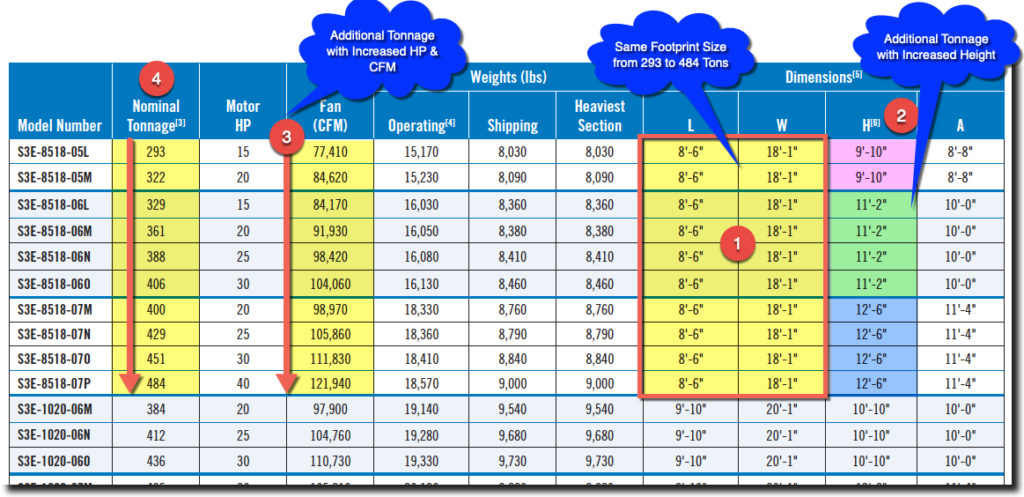
Crossflow cooling towers are better at turndown than counterflow because of the inherent features of their water distribution methods.
Cooling towers are rated based on standard conditions of 95ºF (35.0ºC) entering water temperature to an 85ºF (29.4ºC) leaving water temperature at a 78ºF (25.6ºC) entering wet-bulb temperature. This correlates to 3 GPM of water per nominal ton. For non-standard conditions seek the assistance of your local cooling tower sales representative and their access to tower sizing software.
Cooling Tower Fill – Heat Transfer Surface
Cooling tower manufactures offer options on the type of fill based on factors such as the condition or chemistry of the water and the potential for biological growth. It’s important to prevent scaling which will reduce the capacity and ability of the tower to efficiently reject heat.
The use of PVC for fill material is common due to its low cost and effectiveness in clean water applications. If the water quality is not satisfactory than the use of splash fill might be required which will also increase the cost due to it be less efficient at heat transfer, which will also increase the size of the tower to meet the same project requirements. The use of splash fill is less prone to clogging due to dirty water as opposed to PVC Film which can clog more easily.
Cooling Tower Fans
There are anywhere from one or more fans that provide for the air movement through the towers. The most energy efficient being the axial fan which sits at the top of the tower. The use of centrifugal fans are more commonly used in forced draft fluid coolers.
Summary
Your project requirements and site conditions will determine the best option of either a crossflow or counterflow cooling tower including any consideration for maintenance.


